An Analysis of Leadership Theories and Styles for Tesco PLC
VerifiedAdded on 2020/07/23
|6
|1403
|26
Report
AI Summary
This report provides a comprehensive overview of leadership theories and styles, examining their practical application within the context of Tesco PLC. It begins by defining leadership and its importance in the modern competitive landscape, highlighting the need for organizations to adapt their leadership approaches to retain skilled labor and enhance employee satisfaction. The report then delves into various leadership theories, including behavior, contingency, and transactional leadership, analyzing their strengths and weaknesses and how they apply to Tesco's operations. Furthermore, the report explores different leadership styles, such as autocratic and democratic styles, discussing their characteristics and suitability for different organizational contexts. The report concludes by emphasizing the importance of effective leadership in guiding employees, fostering positive relationships, and achieving organizational goals. The report uses academic sources to support the analysis.
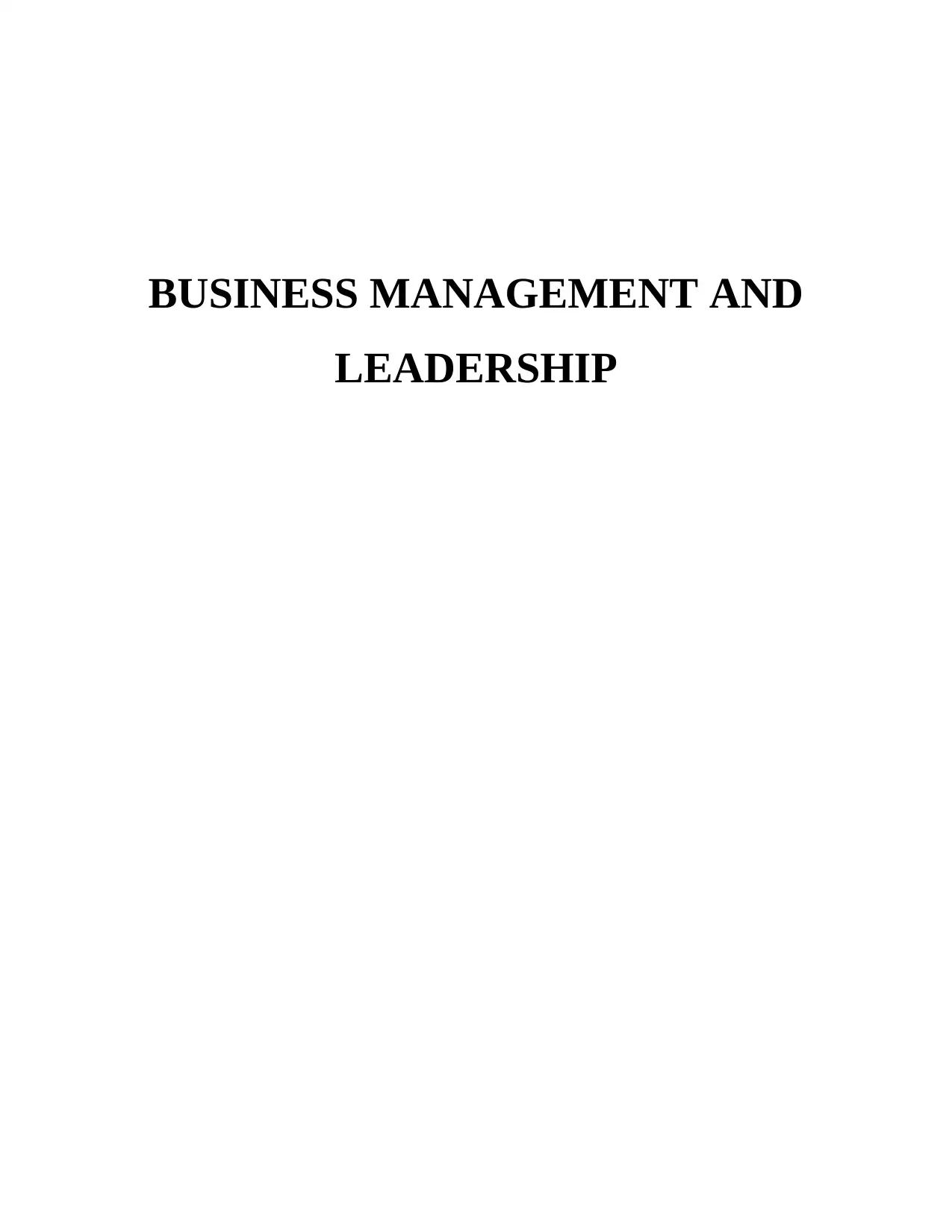
BUSINESS MANAGEMENT AND
LEADERSHIP
LEADERSHIP
Paraphrase This Document
Need a fresh take? Get an instant paraphrase of this document with our AI Paraphraser
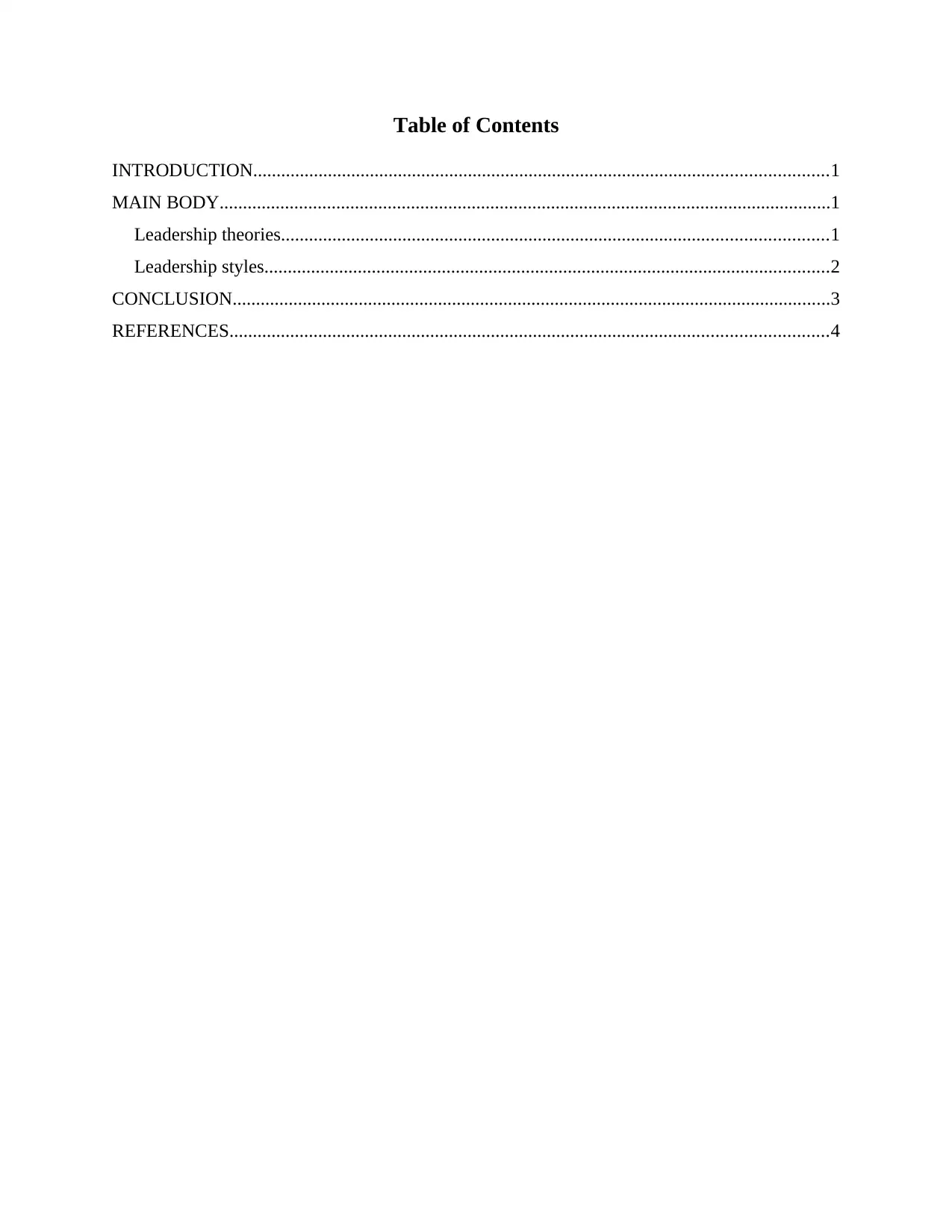
Table of Contents
INTRODUCTION...........................................................................................................................1
MAIN BODY...................................................................................................................................1
Leadership theories.....................................................................................................................1
Leadership styles.........................................................................................................................2
CONCLUSION................................................................................................................................3
REFERENCES................................................................................................................................4
INTRODUCTION...........................................................................................................................1
MAIN BODY...................................................................................................................................1
Leadership theories.....................................................................................................................1
Leadership styles.........................................................................................................................2
CONCLUSION................................................................................................................................3
REFERENCES................................................................................................................................4
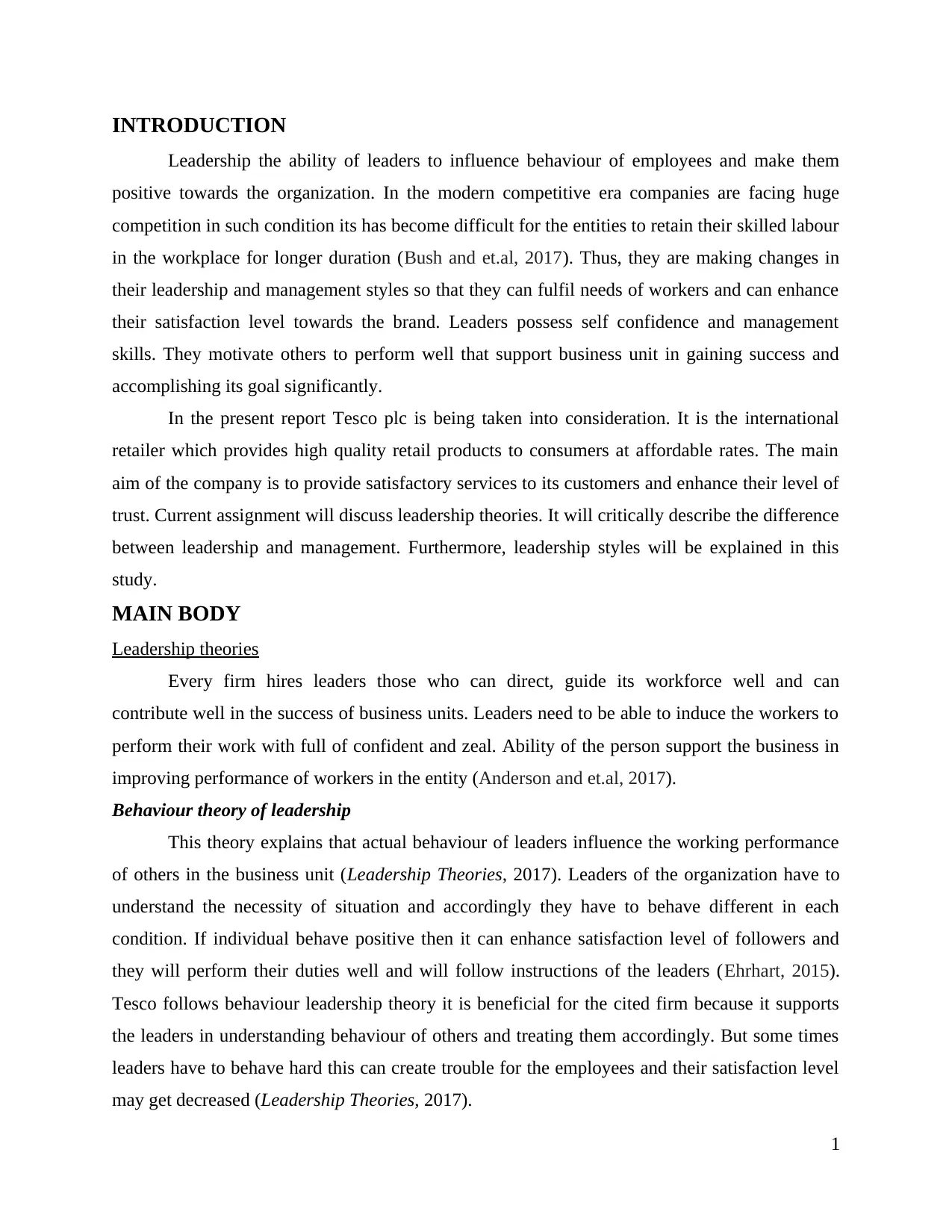
INTRODUCTION
Leadership the ability of leaders to influence behaviour of employees and make them
positive towards the organization. In the modern competitive era companies are facing huge
competition in such condition its has become difficult for the entities to retain their skilled labour
in the workplace for longer duration (Bush and et.al, 2017). Thus, they are making changes in
their leadership and management styles so that they can fulfil needs of workers and can enhance
their satisfaction level towards the brand. Leaders possess self confidence and management
skills. They motivate others to perform well that support business unit in gaining success and
accomplishing its goal significantly.
In the present report Tesco plc is being taken into consideration. It is the international
retailer which provides high quality retail products to consumers at affordable rates. The main
aim of the company is to provide satisfactory services to its customers and enhance their level of
trust. Current assignment will discuss leadership theories. It will critically describe the difference
between leadership and management. Furthermore, leadership styles will be explained in this
study.
MAIN BODY
Leadership theories
Every firm hires leaders those who can direct, guide its workforce well and can
contribute well in the success of business units. Leaders need to be able to induce the workers to
perform their work with full of confident and zeal. Ability of the person support the business in
improving performance of workers in the entity (Anderson and et.al, 2017).
Behaviour theory of leadership
This theory explains that actual behaviour of leaders influence the working performance
of others in the business unit (Leadership Theories, 2017). Leaders of the organization have to
understand the necessity of situation and accordingly they have to behave different in each
condition. If individual behave positive then it can enhance satisfaction level of followers and
they will perform their duties well and will follow instructions of the leaders (Ehrhart, 2015).
Tesco follows behaviour leadership theory it is beneficial for the cited firm because it supports
the leaders in understanding behaviour of others and treating them accordingly. But some times
leaders have to behave hard this can create trouble for the employees and their satisfaction level
may get decreased (Leadership Theories, 2017).
1
Leadership the ability of leaders to influence behaviour of employees and make them
positive towards the organization. In the modern competitive era companies are facing huge
competition in such condition its has become difficult for the entities to retain their skilled labour
in the workplace for longer duration (Bush and et.al, 2017). Thus, they are making changes in
their leadership and management styles so that they can fulfil needs of workers and can enhance
their satisfaction level towards the brand. Leaders possess self confidence and management
skills. They motivate others to perform well that support business unit in gaining success and
accomplishing its goal significantly.
In the present report Tesco plc is being taken into consideration. It is the international
retailer which provides high quality retail products to consumers at affordable rates. The main
aim of the company is to provide satisfactory services to its customers and enhance their level of
trust. Current assignment will discuss leadership theories. It will critically describe the difference
between leadership and management. Furthermore, leadership styles will be explained in this
study.
MAIN BODY
Leadership theories
Every firm hires leaders those who can direct, guide its workforce well and can
contribute well in the success of business units. Leaders need to be able to induce the workers to
perform their work with full of confident and zeal. Ability of the person support the business in
improving performance of workers in the entity (Anderson and et.al, 2017).
Behaviour theory of leadership
This theory explains that actual behaviour of leaders influence the working performance
of others in the business unit (Leadership Theories, 2017). Leaders of the organization have to
understand the necessity of situation and accordingly they have to behave different in each
condition. If individual behave positive then it can enhance satisfaction level of followers and
they will perform their duties well and will follow instructions of the leaders (Ehrhart, 2015).
Tesco follows behaviour leadership theory it is beneficial for the cited firm because it supports
the leaders in understanding behaviour of others and treating them accordingly. But some times
leaders have to behave hard this can create trouble for the employees and their satisfaction level
may get decreased (Leadership Theories, 2017).
1
⊘ This is a preview!⊘
Do you want full access?
Subscribe today to unlock all pages.

Trusted by 1+ million students worldwide
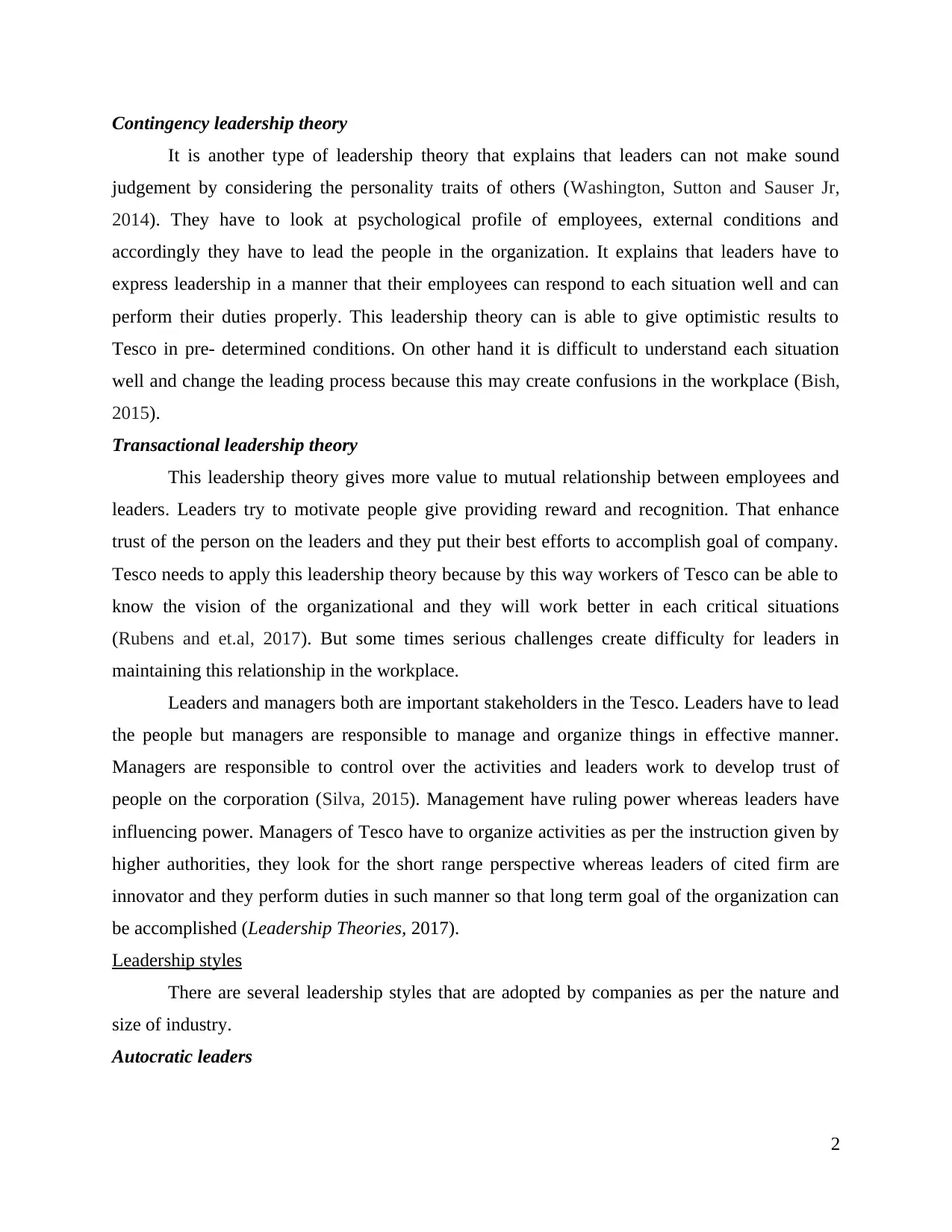
Contingency leadership theory
It is another type of leadership theory that explains that leaders can not make sound
judgement by considering the personality traits of others (Washington, Sutton and Sauser Jr,
2014). They have to look at psychological profile of employees, external conditions and
accordingly they have to lead the people in the organization. It explains that leaders have to
express leadership in a manner that their employees can respond to each situation well and can
perform their duties properly. This leadership theory can is able to give optimistic results to
Tesco in pre- determined conditions. On other hand it is difficult to understand each situation
well and change the leading process because this may create confusions in the workplace (Bish,
2015).
Transactional leadership theory
This leadership theory gives more value to mutual relationship between employees and
leaders. Leaders try to motivate people give providing reward and recognition. That enhance
trust of the person on the leaders and they put their best efforts to accomplish goal of company.
Tesco needs to apply this leadership theory because by this way workers of Tesco can be able to
know the vision of the organizational and they will work better in each critical situations
(Rubens and et.al, 2017). But some times serious challenges create difficulty for leaders in
maintaining this relationship in the workplace.
Leaders and managers both are important stakeholders in the Tesco. Leaders have to lead
the people but managers are responsible to manage and organize things in effective manner.
Managers are responsible to control over the activities and leaders work to develop trust of
people on the corporation (Silva, 2015). Management have ruling power whereas leaders have
influencing power. Managers of Tesco have to organize activities as per the instruction given by
higher authorities, they look for the short range perspective whereas leaders of cited firm are
innovator and they perform duties in such manner so that long term goal of the organization can
be accomplished (Leadership Theories, 2017).
Leadership styles
There are several leadership styles that are adopted by companies as per the nature and
size of industry.
Autocratic leaders
2
It is another type of leadership theory that explains that leaders can not make sound
judgement by considering the personality traits of others (Washington, Sutton and Sauser Jr,
2014). They have to look at psychological profile of employees, external conditions and
accordingly they have to lead the people in the organization. It explains that leaders have to
express leadership in a manner that their employees can respond to each situation well and can
perform their duties properly. This leadership theory can is able to give optimistic results to
Tesco in pre- determined conditions. On other hand it is difficult to understand each situation
well and change the leading process because this may create confusions in the workplace (Bish,
2015).
Transactional leadership theory
This leadership theory gives more value to mutual relationship between employees and
leaders. Leaders try to motivate people give providing reward and recognition. That enhance
trust of the person on the leaders and they put their best efforts to accomplish goal of company.
Tesco needs to apply this leadership theory because by this way workers of Tesco can be able to
know the vision of the organizational and they will work better in each critical situations
(Rubens and et.al, 2017). But some times serious challenges create difficulty for leaders in
maintaining this relationship in the workplace.
Leaders and managers both are important stakeholders in the Tesco. Leaders have to lead
the people but managers are responsible to manage and organize things in effective manner.
Managers are responsible to control over the activities and leaders work to develop trust of
people on the corporation (Silva, 2015). Management have ruling power whereas leaders have
influencing power. Managers of Tesco have to organize activities as per the instruction given by
higher authorities, they look for the short range perspective whereas leaders of cited firm are
innovator and they perform duties in such manner so that long term goal of the organization can
be accomplished (Leadership Theories, 2017).
Leadership styles
There are several leadership styles that are adopted by companies as per the nature and
size of industry.
Autocratic leaders
2
Paraphrase This Document
Need a fresh take? Get an instant paraphrase of this document with our AI Paraphraser
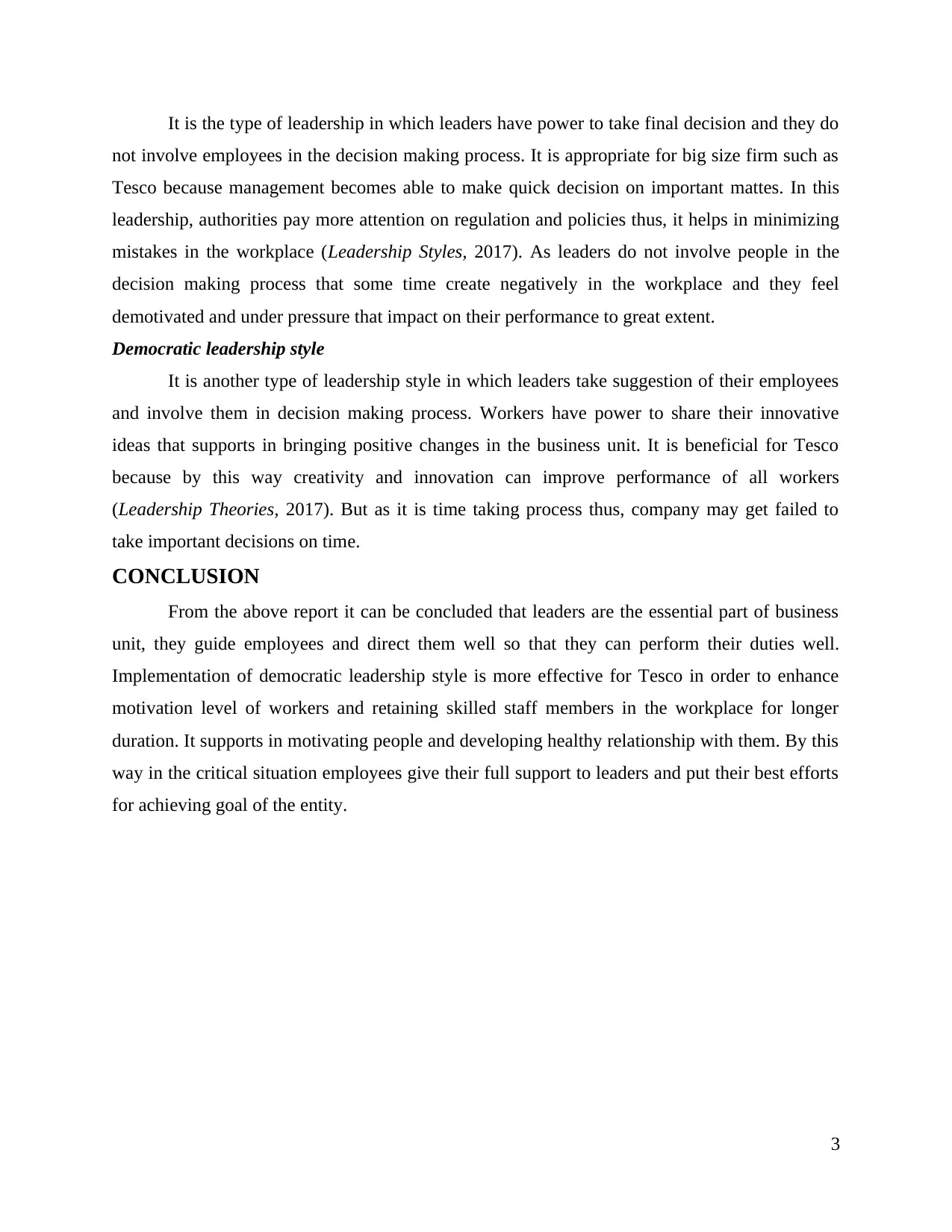
It is the type of leadership in which leaders have power to take final decision and they do
not involve employees in the decision making process. It is appropriate for big size firm such as
Tesco because management becomes able to make quick decision on important mattes. In this
leadership, authorities pay more attention on regulation and policies thus, it helps in minimizing
mistakes in the workplace (Leadership Styles, 2017). As leaders do not involve people in the
decision making process that some time create negatively in the workplace and they feel
demotivated and under pressure that impact on their performance to great extent.
Democratic leadership style
It is another type of leadership style in which leaders take suggestion of their employees
and involve them in decision making process. Workers have power to share their innovative
ideas that supports in bringing positive changes in the business unit. It is beneficial for Tesco
because by this way creativity and innovation can improve performance of all workers
(Leadership Theories, 2017). But as it is time taking process thus, company may get failed to
take important decisions on time.
CONCLUSION
From the above report it can be concluded that leaders are the essential part of business
unit, they guide employees and direct them well so that they can perform their duties well.
Implementation of democratic leadership style is more effective for Tesco in order to enhance
motivation level of workers and retaining skilled staff members in the workplace for longer
duration. It supports in motivating people and developing healthy relationship with them. By this
way in the critical situation employees give their full support to leaders and put their best efforts
for achieving goal of the entity.
3
not involve employees in the decision making process. It is appropriate for big size firm such as
Tesco because management becomes able to make quick decision on important mattes. In this
leadership, authorities pay more attention on regulation and policies thus, it helps in minimizing
mistakes in the workplace (Leadership Styles, 2017). As leaders do not involve people in the
decision making process that some time create negatively in the workplace and they feel
demotivated and under pressure that impact on their performance to great extent.
Democratic leadership style
It is another type of leadership style in which leaders take suggestion of their employees
and involve them in decision making process. Workers have power to share their innovative
ideas that supports in bringing positive changes in the business unit. It is beneficial for Tesco
because by this way creativity and innovation can improve performance of all workers
(Leadership Theories, 2017). But as it is time taking process thus, company may get failed to
take important decisions on time.
CONCLUSION
From the above report it can be concluded that leaders are the essential part of business
unit, they guide employees and direct them well so that they can perform their duties well.
Implementation of democratic leadership style is more effective for Tesco in order to enhance
motivation level of workers and retaining skilled staff members in the workplace for longer
duration. It supports in motivating people and developing healthy relationship with them. By this
way in the critical situation employees give their full support to leaders and put their best efforts
for achieving goal of the entity.
3
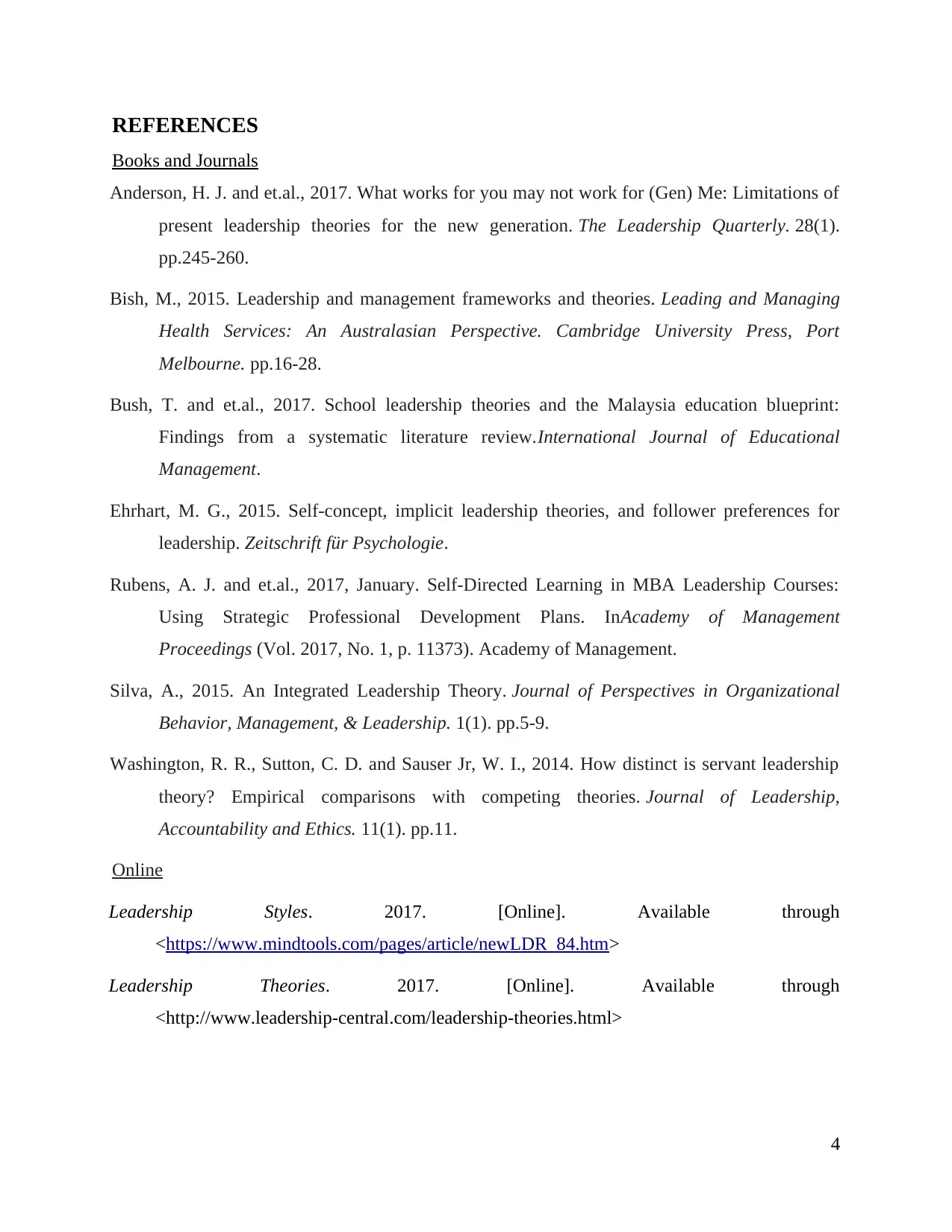
REFERENCES
Books and Journals
Anderson, H. J. and et.al., 2017. What works for you may not work for (Gen) Me: Limitations of
present leadership theories for the new generation. The Leadership Quarterly. 28(1).
pp.245-260.
Bish, M., 2015. Leadership and management frameworks and theories. Leading and Managing
Health Services: An Australasian Perspective. Cambridge University Press, Port
Melbourne. pp.16-28.
Bush, T. and et.al., 2017. School leadership theories and the Malaysia education blueprint:
Findings from a systematic literature review.International Journal of Educational
Management.
Ehrhart, M. G., 2015. Self-concept, implicit leadership theories, and follower preferences for
leadership. Zeitschrift für Psychologie.
Rubens, A. J. and et.al., 2017, January. Self-Directed Learning in MBA Leadership Courses:
Using Strategic Professional Development Plans. InAcademy of Management
Proceedings (Vol. 2017, No. 1, p. 11373). Academy of Management.
Silva, A., 2015. An Integrated Leadership Theory. Journal of Perspectives in Organizational
Behavior, Management, & Leadership. 1(1). pp.5-9.
Washington, R. R., Sutton, C. D. and Sauser Jr, W. I., 2014. How distinct is servant leadership
theory? Empirical comparisons with competing theories. Journal of Leadership,
Accountability and Ethics. 11(1). pp.11.
Online
Leadership Styles. 2017. [Online]. Available through
<https://www.mindtools.com/pages/article/newLDR_84.htm>
Leadership Theories. 2017. [Online]. Available through
<http://www.leadership-central.com/leadership-theories.html>
4
Books and Journals
Anderson, H. J. and et.al., 2017. What works for you may not work for (Gen) Me: Limitations of
present leadership theories for the new generation. The Leadership Quarterly. 28(1).
pp.245-260.
Bish, M., 2015. Leadership and management frameworks and theories. Leading and Managing
Health Services: An Australasian Perspective. Cambridge University Press, Port
Melbourne. pp.16-28.
Bush, T. and et.al., 2017. School leadership theories and the Malaysia education blueprint:
Findings from a systematic literature review.International Journal of Educational
Management.
Ehrhart, M. G., 2015. Self-concept, implicit leadership theories, and follower preferences for
leadership. Zeitschrift für Psychologie.
Rubens, A. J. and et.al., 2017, January. Self-Directed Learning in MBA Leadership Courses:
Using Strategic Professional Development Plans. InAcademy of Management
Proceedings (Vol. 2017, No. 1, p. 11373). Academy of Management.
Silva, A., 2015. An Integrated Leadership Theory. Journal of Perspectives in Organizational
Behavior, Management, & Leadership. 1(1). pp.5-9.
Washington, R. R., Sutton, C. D. and Sauser Jr, W. I., 2014. How distinct is servant leadership
theory? Empirical comparisons with competing theories. Journal of Leadership,
Accountability and Ethics. 11(1). pp.11.
Online
Leadership Styles. 2017. [Online]. Available through
<https://www.mindtools.com/pages/article/newLDR_84.htm>
Leadership Theories. 2017. [Online]. Available through
<http://www.leadership-central.com/leadership-theories.html>
4
⊘ This is a preview!⊘
Do you want full access?
Subscribe today to unlock all pages.

Trusted by 1+ million students worldwide
1 out of 6
Related Documents
Your All-in-One AI-Powered Toolkit for Academic Success.
+13062052269
info@desklib.com
Available 24*7 on WhatsApp / Email
![[object Object]](/_next/static/media/star-bottom.7253800d.svg)
Unlock your academic potential
Copyright © 2020–2025 A2Z Services. All Rights Reserved. Developed and managed by ZUCOL.





